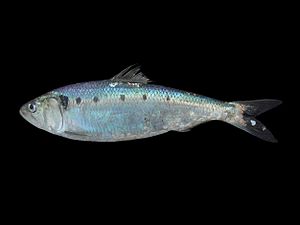Alosinae facts for kids
Quick facts for kids Alosinae |
|
|---|---|
 |
|
| Twaite shad, Alosa fallax | |
| Scientific classification |
|
| Kingdom: | Animalia |
| Phylum: | Chordata |
| Class: | Actinopterygii |
| Order: | Clupeiformes |
| Family: | Clupeidae |
| Subfamily: | Alosinae |
| Genera | |
|
|
The Alosinae, often called shads, are a group of fish that belong to the herring family, called Clupeidae. Think of them as a smaller branch within the larger herring family tree. There are about 30 different kinds of shads found all over the world, grouped into seven main types, or genera.
Shads are known for living in the open ocean, but many of them also travel to rivers to lay their eggs. They often swim together in large groups called schools. Some types of shads are very important for fishing because people catch them for food.
Contents
What Are Shads?
Shads are a special group of fish within the herring family. They are known for their shiny, silver scales and streamlined bodies, which help them swim fast. Most shads have a deep body and a forked tail. They are usually found in coastal waters, but some species spend part of their lives in freshwater.
How Shads Are Classified
In the world of science, shads are a "subfamily." This means they are a smaller group of animals that are closely related to each other, and they all belong to a larger family. The larger family for shads is the Clupeidae family, which includes all herrings, sardines, and anchovies.
Where Do Shads Live?
Shads are mostly pelagic fish. This means they live in the open water, not usually near the bottom of the ocean or close to the shore. They love to swim in large groups, which is called schooling. Swimming in schools helps them find food and protects them from bigger predators.
Traveling Between Waters
Many shads are anadromous. This is a fancy word for fish that live most of their lives in saltwater (like the ocean) but travel to freshwater (like rivers or lakes) to lay their eggs. It's a bit like salmon, which also make long journeys upstream. After laying their eggs, adult shads often return to the ocean. Their young fish, called fry, grow up in the rivers before heading out to sea.
Some shads are even landlocked. This means they live their entire lives in freshwater lakes or rivers and do not travel to the ocean. This usually happens when their path to the sea is blocked, perhaps by dams or natural changes in the landscape.
Types of Shads
There are several important types of shads. Each type has its own unique features and habitats.
- Alosa: These are often called "river herrings." Many species in this group are anadromous, meaning they swim up rivers to spawn. Examples include the American shad and the Twaite shad.
- Brevoortia: These shads are known as "menhadens." They are very important in the ocean's food chain because they eat tiny plants and animals (plankton) and are a major food source for larger fish, birds, and marine mammals.
- Hilsa: The most famous species here is the Hilsa shad, which is very popular for food in parts of Asia.
Why Are Shads Important?
Shads play a big role in both nature and for people.
In the Ecosystem
Shads are a vital part of the ocean's food web. They eat tiny organisms like plankton, helping to keep the ocean clean. In turn, they become food for many other animals, including bigger fish like tuna, sharks, and even dolphins. Birds like ospreys and eagles also hunt shads. Their migrations also bring nutrients from the ocean into freshwater ecosystems.
For People
Many types of shads are important for fishing. People catch them for food, especially in certain parts of the world where they are a traditional dish. For example, the American shad was very important to early settlers in North America. Menhadens are often caught not just for food, but also to make fish oil, fish meal (used in animal feed), and fertilizers.
Conservation of Shads
Because shads are so important, people are working to protect them. Overfishing and pollution can harm shad populations. Building dams on rivers can also block their migration paths, making it hard for them to reach their spawning grounds. Efforts to help shads include building fish ladders (which help fish get over dams) and setting limits on how many fish can be caught. Protecting their habitats is also key to making sure these amazing fish continue to thrive.

